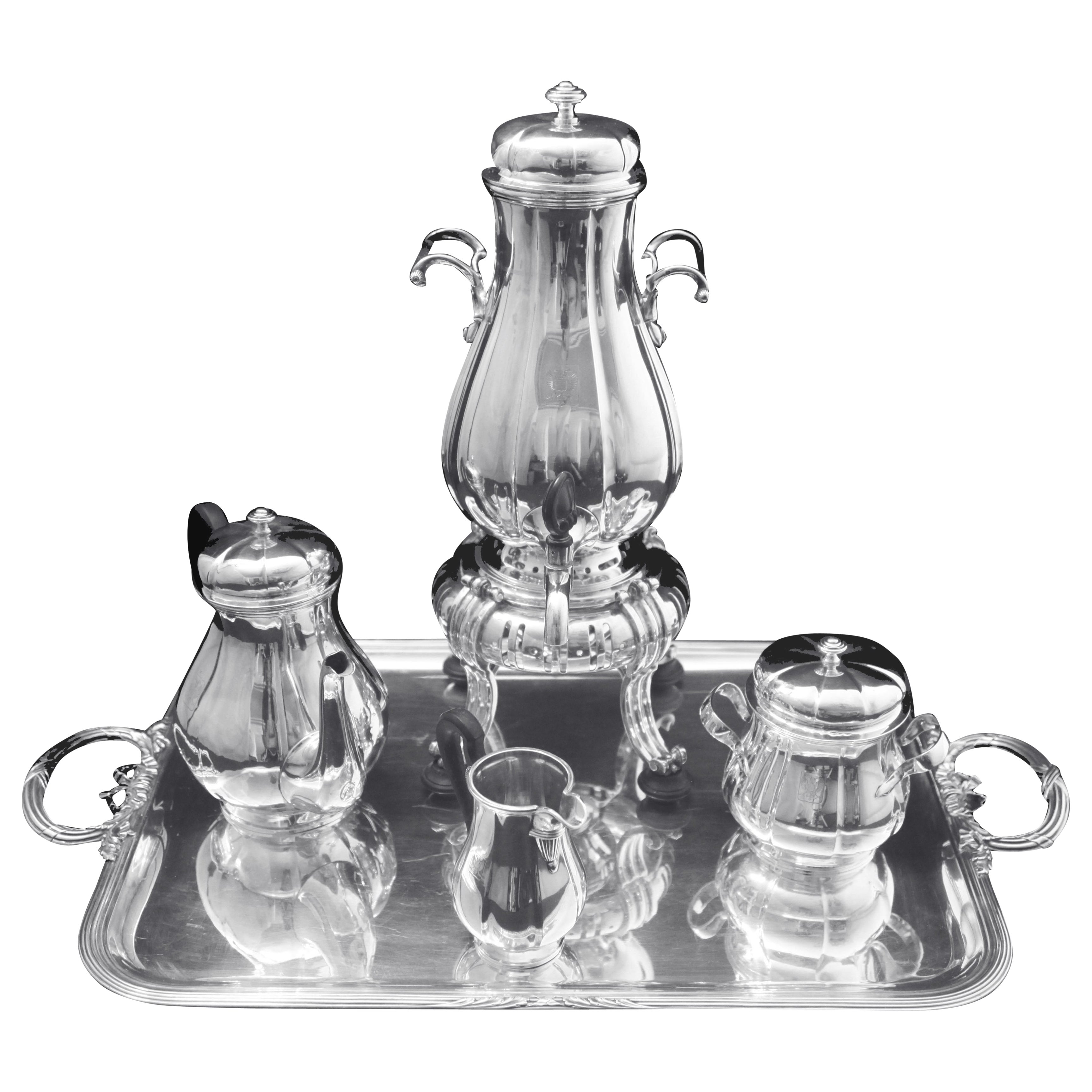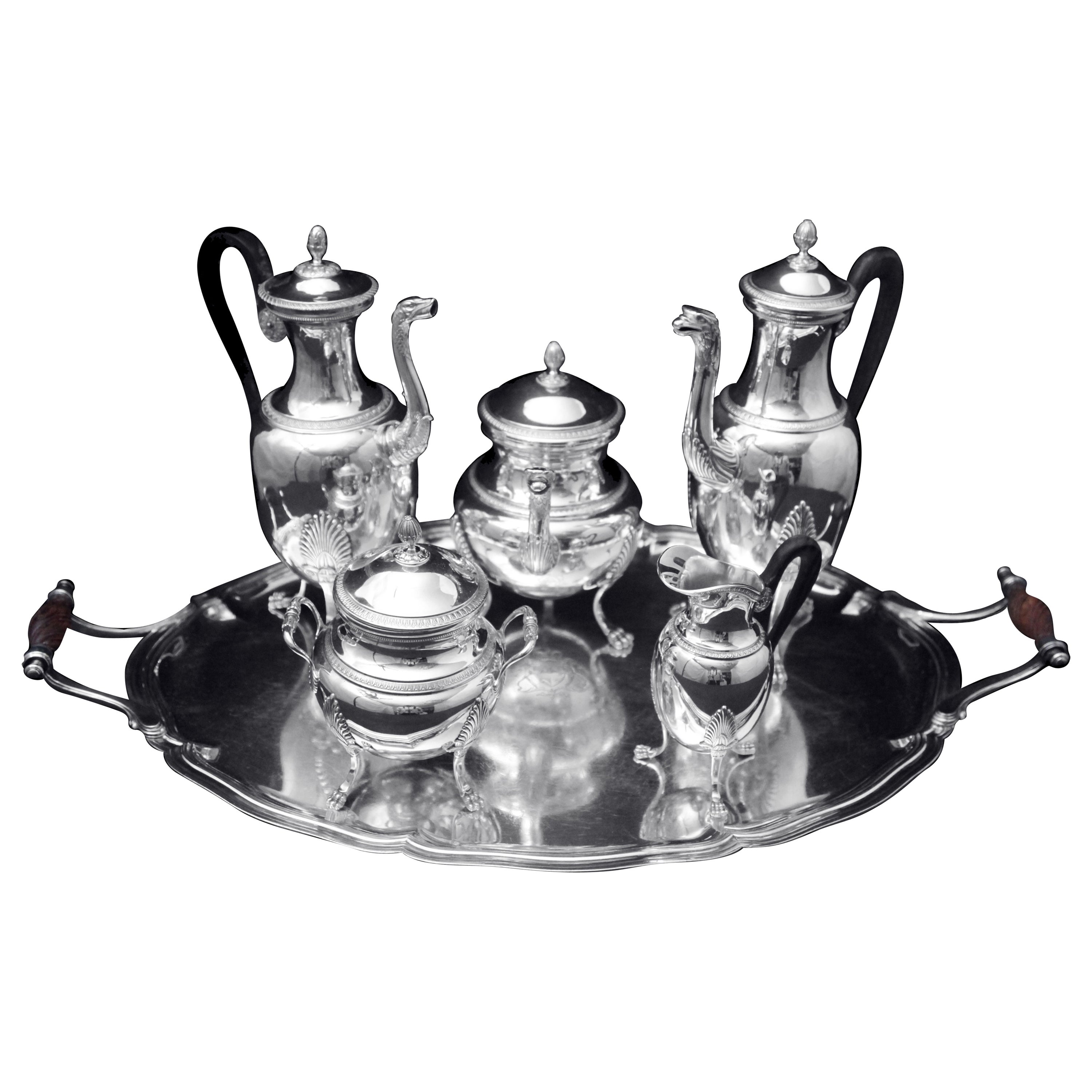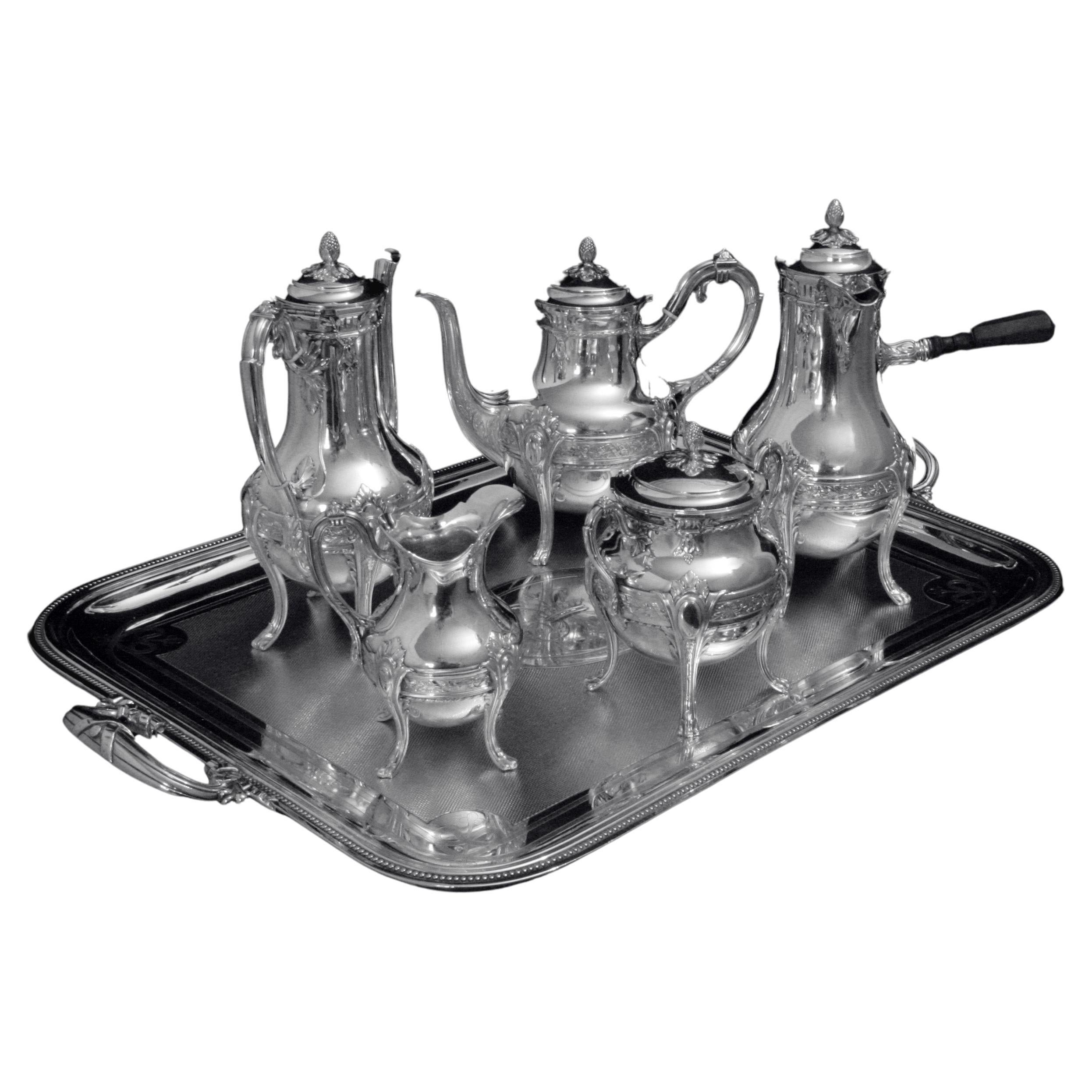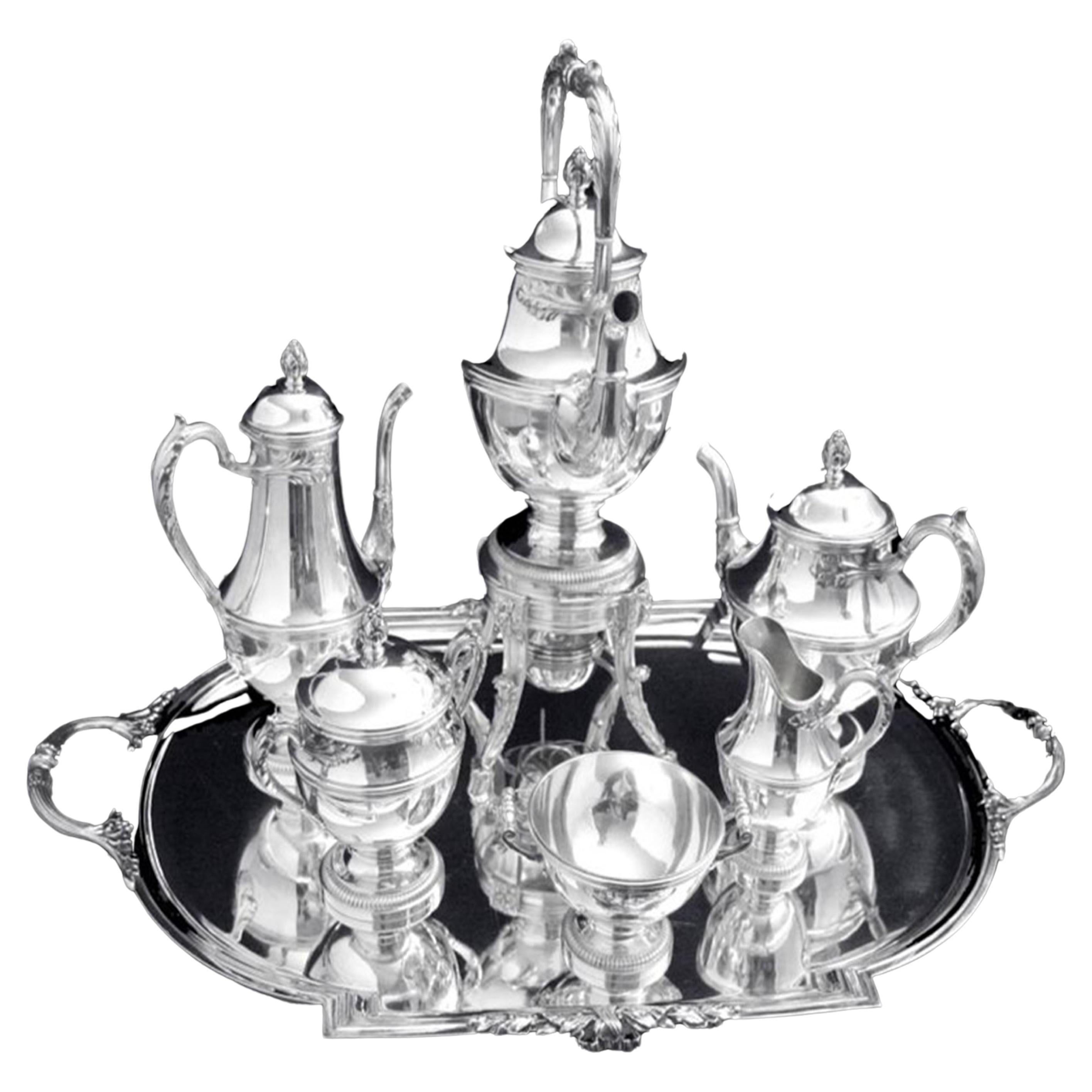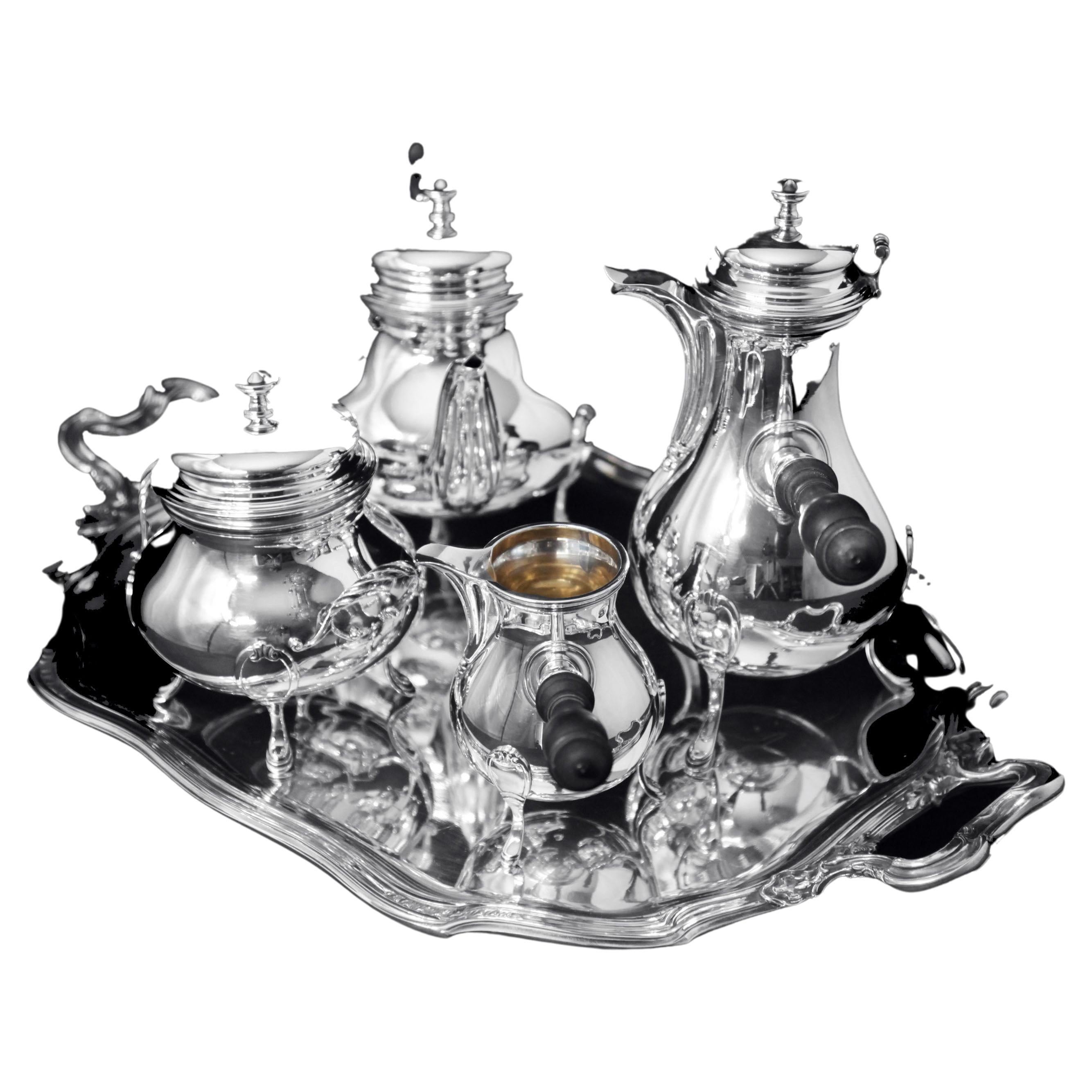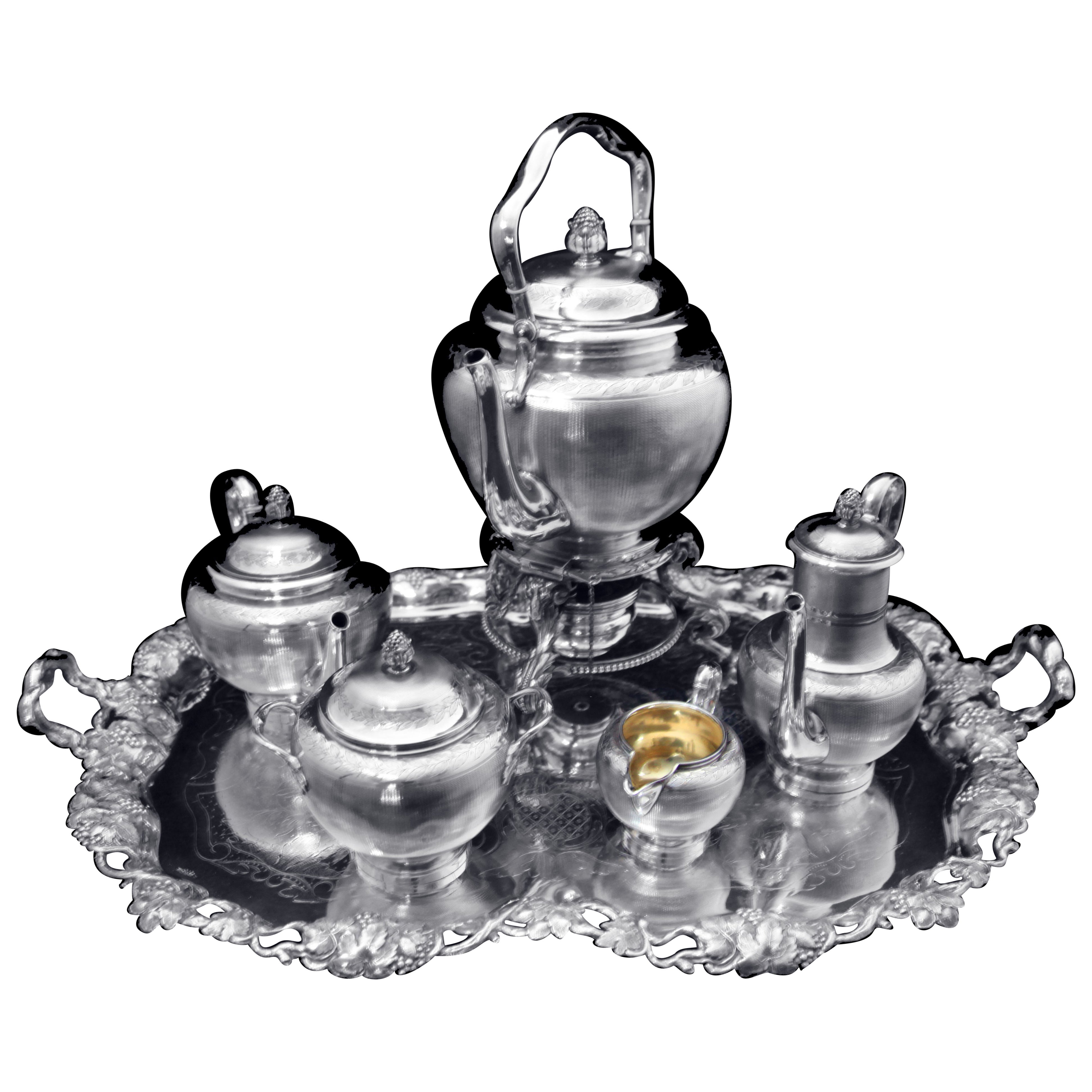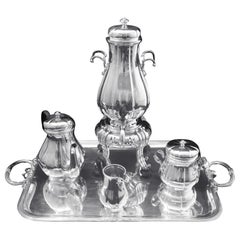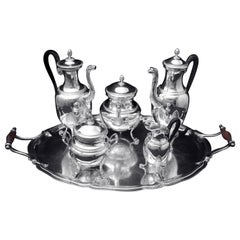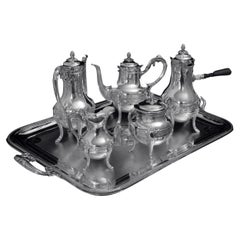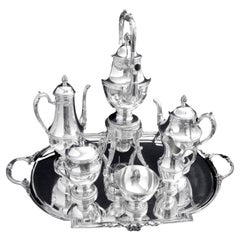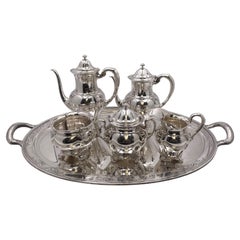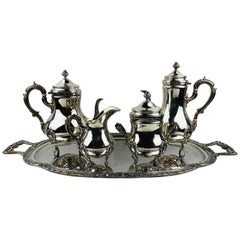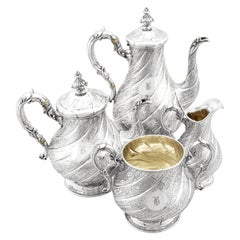Items Similar to Queille - Magnificent 5pc. Antique French 950 Sterling Silver Tea Set + Wraps !
Want more images or videos?
Request additional images or videos from the seller
1 of 17
Queille - Magnificent 5pc. Antique French 950 Sterling Silver Tea Set + Wraps !
$24,088per set
£18,287.20per set
€20,916.65per set
CA$33,654.43per set
A$37,431.07per set
CHF 19,545.34per set
MX$455,496.32per set
NOK 249,623.85per set
SEK 234,103.13per set
DKK 156,109.01per set
Shipping
Retrieving quote...The 1stDibs Promise:
Authenticity Guarantee,
Money-Back Guarantee,
24-Hour Cancellation
About the Item
Direct from Paris, a magnificent 5pc. antique French 950 sterling silver tea set, Louis XVI model, by internationally known French silversmith Pierre Queille, with accompanying 5 anti-tarnish storage wraps for easy storage. Pierre Queille is a name that resonates with the elegance, refinement, and impeccable craftsmanship of 19th-century French silversmithing. Renowned for his exquisite sterling silver creations, Queille has left an indelible mark on the world of decorative arts, particularly through his magnificent 950 silver tea sets. His work is not merely functional but a testament to the artistry and technical prowess that defined French silverware during the period.
Pierre Queille was born into a world where craftsmanship and artistry were held in high esteem. From a young age, he was exposed to the rich tradition of French silversmithing, a craft that had been refined over centuries. His early training was rigorous, involving not only the development of technical skills but also an immersion in the artistic and cultural heritage that informed the aesthetics of the time. By the time Queille established his workshop in Paris, he had already mastered the skills that would make him one of the leading silversmiths of his era.
The hallmark of Pierre Queille’s work is its exceptional quality. Every piece that left his workshop was a testament to his commitment to excellence. Queille’s silverware is characterized by its meticulous attention to detail, the harmonious proportions of its forms, and the flawless execution of its decorative elements. His work reflects a deep understanding of the material he was working with and a mastery of the techniques required to manipulate it. A distinguishing feature of Queille’s work is the precision and skill with which he executed even the most complex designs. His pieces often featured intricate engravings, repoussé work, and chased details, all of which required a high degree of skill and patience to achieve. These techniques allowed Queille to add depth and texture to his pieces, creating a sense of movement and life that set his work apart from that of his contemporaries.
Pierre Queille’s exceptional craftsmanship did not go unnoticed. Throughout his career, he received numerous awards and accolades, which served as formal recognition of his contributions to the field of silversmithing. One of the most significant recognitions Queille received was his participation in the Exposition Universelle, the world’s fair held in Paris in 1867. The Exposition Universelle was one of the most prestigious events of the 19th century, showcasing the finest achievements in art, industry, and technology from around the world. Queille’s display at the Exposition Universelle was met with great acclaim. His work was praised for its beauty, technical excellence, and originality. The judges awarded him a medal, recognizing his contributions to the advancement of the art of silversmithing. This award was particularly significant because it placed Queille among the elite of French artisans, those whose work was considered to represent the pinnacle of the nation’s artistic achievement.
One of the ultimate marks of distinction for any artist or craftsman in 19th-century France was to receive the patronage of the royal family or the aristocracy. Pierre Queille was fortunate to have garnered the favor of several prominent figures, whose patronage helped to elevate his status and secure his place among the leading silversmiths of his era. Among Queille’s most notable patrons was Emperor Napoleon III, who reigned over France from 1852 to 1870. Napoleon III was known for his appreciation of the arts and for his efforts to promote French culture and industry. He was a great supporter of the Exposition Universelle and took a personal interest in the work of the artisans who exhibited there. Queille’s success at the 1867 exposition was instrumental in securing Napoleon’s patronage.
Napoleon III’s wife, Empress Eugénie, was also a significant patron of the arts, particularly in the field of decorative arts. She had a keen interest in luxury goods and was known for her exquisite taste. The Empress’s patronage was highly sought after by artisans, as it could lead to commissions for the royal household and other members of the aristocracy. Queille’s work, with its combination of technical excellence and artistic beauty, was perfectly suited to the tastes of the Empress, and she owned several pieces of his silverware. The patronage of the royal family not only brought Queille prestige but also provided him with the opportunity to create some of his most magnificent works. Royal commissions often required pieces that were not only functional but also highly decorative, meant to impress guests and demonstrate the wealth and power of the royal household. Queille rose to the occasion, creating works that were both opulent and refined, embodying the grandeur of the Second Empire.
Among Pierre Queille’s many creations, his 950 sterling silver tea sets stand out as some of his most iconic works. These tea sets are a perfect example of Queille’s ability to combine form and function, creating pieces that were both beautiful and practical. They are also a testament to his mastery of silverworking techniques, as they often feature complex designs and intricate details that could only be achieved by a true master.
The tea set was a central element of 19th-century European domestic life, particularly among the upper classes. It was used not only for serving tea but also as a display of wealth and sophistication. As such, the design of a tea set was of great importance, and it needed to reflect the status of its owner. Queille’s tea sets were ideally suited to this purpose, as they combined the elegance and refinement that were expected of such pieces with a level of craftsmanship that set them apart from those of his contemporaries. In addition to their decorative elements, Queille’s tea sets were also noted for their functional design. The handles, spouts, and lids of the various components were carefully crafted to ensure that they were comfortable to use and that the pieces poured smoothly without drips. This combination of beauty and practicality is one of the reasons why Queille’s tea sets were so popular among his clients and why they remain highly sought after by collectors today.
One of the most famous examples of Queille’s tea sets is the one he created for the Exposition Universelle in 1867. This set, which was awarded a medal at the exposition, is a masterpiece of 19th-century silverwork. Another notable example of Queille’s tea sets is one that was commissioned by a member of the French aristocracy. This set, which is now in a private collection, is a stunning example of Queille’s ability to combine traditional design elements with a modern sensibility.
Queille’s work has also had a significant impact on the market for antique silver. His pieces are highly sought after by collectors, who appreciate the quality of his craftsmanship and the beauty of his designs. The rarity and desirability of his work have led to high prices at auction, and his pieces are considered some of the most valuable examples of 19th-century French silverware. In addition to his influence on the market, Queille’s work has also been the subject of academic study and exhibition. His pieces have been featured in numerous exhibitions of 19th-century decorative arts, where they have been recognized for their artistic and technical merit. Scholars have also studied his work in the context of the broader history of French silverware, examining how his designs reflect the social and cultural changes of his time.
This amazing 5pc., 950 sterling silver tea set exemplifies the highest standards of 19th-century French craftsmanship. Reflecting Queille’s exceptional skill, innovative design, and commitment to quality have earned him a place among the great artisans of his era. The magnificent tea pot stands roughly 18.50 cm. high to the top of the lid, is approximately 22.00 cm. across from the tip of the spout to the outside of the handle and weights 610 grams. It is stamped with the French Government’s Head of the Minerva 1 hallmark in addition to the Pierre Queille sterling silver manufacturer’s hallmark. It comes with its own anti-tarnish storage wrap for easy storage. The gorgeous coffee pot stand 23.00 cm. high to the top of the lid, is roughly 22.00 cm. across from the tip fo the spout to the outside of the handle and weights 688 grams. It is stamped with the French Government’s Head of the Minerva 1 hallmark in addition to the Pierre Queille sterling silver manufacturer’s hallmark. It comes with its own anti-tarnish storage wrap for easy storage. The elegant sugar bowl with vermeil (gold plated interior) is 14.50 cm. in height to the top of the lid, 18.50 cm. across to the outside of the handles and weights 497 grams. It is stamped with the French Government’s Head of the Minerva 1 hallmark in addition to the Pierre Queille sterling silver manufacturer’s hallmark. It comes with its own anti-tarnish storage wrap for easy storage. The elegant cream pitcher is roughly 13.50 cm. in height to the top of the handle, 12.00 cm. across from the tip of the spout to the outside of the handle and weights 185 grams. It is stamped with the French Government’s Head of the Minerva 1 hallmark in addition to the Pierre Queille sterling silver manufacturer’s hallmark. It comes with its own anti-tarnish storage wrap for easy storage. The massive serving tray measures 64.00 cm. in length to the outside of the handles, 39.00 cm. across at its widest point and weights an amazing 2,400 grams. It is stamped with the French Government’s Head of the Minerva 1 hallmark in addition to the Pierre Queille sterling silver manufacturer’s hallmark. It comes with its own anti-tarnish storage wrap for easy storage.
- Creator:Pierre François Queille 1 (Manufacturer)
- Sold As:Set of 5
- Style:Louis XV (In the Style Of)
- Materials and Techniques:
- Place of Origin:
- Period:
- Date of Manufacture:1890s
- Condition:Refinished. Each piece has been professionally refinished.
- Seller Location:Wilmington, DE
- Reference Number:1stDibs: LU9583241876932
About the Seller
No Reviews Yet
Vetted Professional Seller
Every seller passes strict standards for authenticity and reliability
1stDibs seller since 2023
6 sales on 1stDibs
- ShippingRetrieving quote...Shipping from: Paris, France
- Return Policy
Authenticity Guarantee
In the unlikely event there’s an issue with an item’s authenticity, contact us within 1 year for a full refund. DetailsMoney-Back Guarantee
If your item is not as described, is damaged in transit, or does not arrive, contact us within 7 days for a full refund. Details24-Hour Cancellation
You have a 24-hour grace period in which to reconsider your purchase, with no questions asked.Vetted Professional Sellers
Our world-class sellers must adhere to strict standards for service and quality, maintaining the integrity of our listings.Price-Match Guarantee
If you find that a seller listed the same item for a lower price elsewhere, we’ll match it.Trusted Global Delivery
Our best-in-class carrier network provides specialized shipping options worldwide, including custom delivery.More From This Seller
View AllCardeilhac: 5pc. French Antique Sterling Tea Set with Puiforcat Sterling Tray !
By Puiforcat, Cardeilhac
Located in Wilmington, DE
Direct from Paris, a magnificent 5pc. sterling silver tea set by two of France’s premier silversmiths “Cardeilhac” and “Puiforcat”, currently owned by Hermes. The set is in like con...
Category
Antique Late 19th Century French Louis XVI Sterling Silver
Materials
Sterling Silver
$37,141 / set
Free Shipping
Puiforcat (Hermes) - 6pc. French Empire Sterling Silver Tea Set, Like New !
By Puiforcat
Located in Wilmington, DE
Direct from Paris: Direct from private mansion in Paris, a magnificent 6 piece antique French sterling silver Empire style tea set by France’s premier silversmith “Puiforcat” – currently owned by Hermes. The art of silversmithing has long been a hallmark of French craftsmanship, embodying the nation's rich cultural heritage and its unwavering commitment to luxury and quality. Among the most illustrious names in this venerable tradition is Puiforcat, a brand synonymous with excellence, innovation, and timeless elegance. Founded in the early 19th century, Puiforcat has established itself as a paragon of fine silverware, producing pieces that are not only functional but also works of art.
The History of Puiforcat: The story of Puiforcat begins in 1820 when Jean-Baptiste Fuchs established a silversmith workshop in Paris. The brand quickly gained recognition for its exceptional craftsmanship and innovative designs, attracting a discerning clientele that included royalty, aristocrats, and wealthy industrialists. At the heart of Puiforcat's enduring appeal is its unwavering commitment to quality and craftsmanship. Each piece of Puiforcat silverware...
Category
Early 20th Century French Empire Tea Sets
Materials
Sterling Silver
$25,362 / set
Free Shipping
Doutre Roussel - 5pc Antique French 950 Sterling Silver Tea Set + Serving Tray !
By Christofle, Claude Doutre Roussel
Located in Wilmington, DE
Direct from Paris, a stunning Louis XVI, 6-piece sterling silver tea / coffee set in near new condition by two of France's premier silversmiths "Claude Doutre-Roussel" and "Christofl...
Category
Antique Late 19th Century French Louis XVI Sterling Silver
Materials
Silver Plate, Sterling Silver
$17,510 / set
Free Shipping
Keller - 8pc. Louis XVI 19th Century 950 Sterling Silver Tea Set, Museum Quality
By Gustave Keller Freres
Located in Wilmington, DE
Keller 8pc. Tea Set – Description
Direct from Paris, A Gorgeous 19th Century Louis XVI, 8 pc. 950 Sterling Silver Tea / Coffee Set by one of France's Premier Silversmiths, Gustave Keller, Includes a Large Sterling Silver Serving Tray...
Category
Antique 1890s French Louis XVI Tea Sets
Materials
Sterling Silver
$33,239 / set
Free Shipping
Odiot Henin - 5pc. Antique French 950 Sterling Silver Louis XVI Tea Set + Tray
By Odiot, Henin et Cie 1
Located in Wilmington, DE
Direct from a Private Mansion in Paris, a Magnificent 4pc. Antique French 950 Sterling Silver and Vermeil Tea Set by France's Premier French Silversmith Jean-Baptiste Odiot and an ac...
Category
Antique Late 19th Century French Louis XVI Tea Sets
Materials
Vermeil, Sterling Silver
$21,209 / set
Free Shipping
Odiot - 6pc. Antique French Sterling Silver Tea Set, Like New Condition, 1890s !
By Odiot
Located in Wilmington, DE
Direct from Paris, a stunning 6pc. silver tea set by one of France’s premier silversmiths “Odiot”, professionally refinished to like new condition and with no monograms on any of the...
Category
Antique Late 19th Century French Louis XVI Tea Sets
Materials
Silver Plate, Sterling Silver
$13,492 / set
Free Shipping
You May Also Like
Tiffany & Co. Sterling Silver 6-Piece Tea & Coffee Set on Tray
By Tiffany & Co.
Located in New York, NY
Tiffany & Co. sterling silver 6-piece tea and coffee set, possibly in the Holly pattern, in pattern number 12827 from 1896, beautifully adorned with stylized leaf and grape motifs, a...
Category
Antique Late 19th Century American Tea Sets
Materials
Silver, Sterling Silver
Early 20th Century Five-Piece Louis XV Style Sterling Silver Tea and Coffee Set
Located in Los Angeles, CA
A very fine early 20th century five-piece Louis XV style sterling silver tea and coffee service set. The finely chased ovoid shaped ...
Category
Early 20th Century Argentine Louis XV Tea Sets
Materials
Silver
$6,895 Sale Price / set
44% Off
20th Century Five-Piece Silver Plate Tea and Coffee Service
Located in Miami, FL
Beautiful early 20th century French or other European nation five-piece tea and coffee service, comprised of a coffee and teapot, covered sugar bowl, creamer all on a impressively si...
Category
Early 20th Century French Baroque Serving Pieces
Materials
Silver Plate
$1,530 Sale Price / set
47% Off
Victorian Sterling Silver Four-Piece Tea and Coffee Service
By Robert Hennell III
Located in Jesmond, Newcastle Upon Tyne
An exceptional, fine and impressive, composite antique Victorian English sterling silver four-piece tea and coffee service/set; part of our silver teaware collection.
This exceptional antique Victorian four-piece sterling silver tea and coffee service consists of a coffee pot, teapot, sugar bowl and cream jug.
Each piece has a pear shaped form onto a circular spreading foot.
The pieces of this Victorian tea and coffee set are embellished with embossed panels in a swirl design, accented with bright cut engraved segmented quatrefoil leaf motifs on a textured background.
One side of each piece incorporates a circular cartouche displaying the engraved initial 'B'.
The upper rims are encompassed with plain applied moulded borders.
The teapot and coffee pot are fitted with domed hinged hallmarked covers reflecting the identical decoration as that to the body.
Each cover retains the original hallmarked cast sterling silver finial embellished with scrolling leaf ornamentation.
The components of this antique silver tea set...
Category
Antique 1860s British Victorian Tea Sets
Materials
Silver, Sterling Silver
Wilcox International Silver Co Silver Plated Tea Set w/ Serving Tray - 5 pc Set
By International Silver
Located in Philadelphia, PA
Vintage Victorian Wilcox International Silver Co Silver Plated Tea Set w/ Serving Tray - 5 pc Set. Listing includes (1) serving tr...
Category
Mid-20th Century Unknown Victorian Tea Sets
Materials
Silver Plate
Antique Five Piece E. B. Maltby Silver Plated Tea Set C1890
Located in Big Flats, NY
Antique Five Piece E. B. Maltby Silver Plated Tea Set with Foliate Engraving C1890
Measures - 10.5"H x 8.5"W x 5"D (Largest)
Category
Antique 19th Century Sheffield and Silverplate
Materials
Silver Plate
$440 Sale Price / set
20% Off
More Ways To Browse
Antique Rose Bowl
Napoleon Engraving
Emperor Empress Art
Rose Bowl Gold
French Napoleon Iii Tray
Black And Gold Tea Set
Repousse Tea Set
Repousse Silver Tea Set
French Vermeil Serving Pieces
Arts And Crafts Silver Coffee Pot
Repousse Sterling Silver Trays
Vermeil Tea And Coffee Set
Antique Sterling Silver Purse
Birks Of Canada
Clear Glass Antique Dishes
Georg Jensen Acanthus Spoon
Heritage Server
Italian 800 Silver Tray
